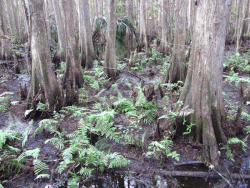From Wikipedia
Open on Wikipedia
| Telmatoblechnum serrulatum | |
|---|---|

| |
| Underside of frond | |

| |
| With Taxodium distichum | |
| Scientific classification | |
| Kingdom: | Plantae |
| Clade: | Tracheophytes |
| Division: | Polypodiophyta |
| Class: | Polypodiopsida |
| Order: | Polypodiales |
| Suborder: | Aspleniineae |
| Family: | Blechnaceae |
| Genus: | Telmatoblechnum |
| Species: | T. serrulatum
|
| Binomial name | |
| Telmatoblechnum serrulatum | |

| |
| Swamp Fern Range[1] | |
| Synonyms[2] | |
|
List
| |
Telmatoblechnum serrulatum, the toothed midsorus fern, is a species of fern in the family Blechnaceae, native to Florida, southeastern Mexico, Central America, the Caribbean, northern and western South America, Brazil, Paraguay, and northeastern Argentina.[2]
Ecology and habitat
[edit]The species is commonly found in freshwater marsh and swamp conditions in tropical or subtropical locations. It can also be found wet prairies, moist pine woods, and sometimes in forests[3] Specifically, in Florida the recorded habitat for this fern is moist and shady places.[4] The range for this fern species is from Florida to South America and has been recorded in Malaysia and Australia.[3]
It has shown good resistance to lead contamination when growing on coal mine tailings.[5]
Description
[edit]This fern is comparable to other ferns that consist of a stipe growing from the rhizomes and pinnae growing from the rachis.[3] The entire above-ground specimen is called the frond. The fronds for this species are monomorphic and typically are about 30-50 cm in length and 7-16 cm wide.[3] This means that this fern can grow a bit more than four feet tall. At the base, the stipe is usually light brown, sometimes darker at the base, typically 10-70 cm long, and appears cylindrical.[3] The rhizomes form horizontally, even sometimes climbing tree trunks, and are covered in dark brown scales.[3] There is the presence of spores which are located on the underside of the pinnae, usually tan to brown in color. Additionally, there is a central costa that runs the length of the pinnae.[3]
Conservation
[edit]This fern species has not been evaluated for conservation measures.[6] However, this species has been utilized for wetland restoration projects.[4]
References
[edit]- ^ "GBIF".
- ^ a b Hassler, Michael (2023). "Telmatoblechnum serrulatum (Rich.) Perrie, D.J.Ohlsen & Brownsey; Taxon 63(4): 755 (2014)". worldplants.de. World Ferns. Synonymic Checklist and Distribution of Ferns and Lycophytes of the World. Version 15.2. Retrieved 13 April 2023.
Name: Swamp Fern, Saw Fern, Toothed midsorus fern (EN)
- ^ a b c d e f g [ Rolleri, C. H., Prada, C., Gabriel y Galán, J. M., Passarelli, L. M., & Ciciarelli, M. M. (2010). Morphology of the sporophyte and gametophyte of the swamp fern, Blechnum serrulatum (Blechnaceae, Pteridophyta). Australian Journal of Botany, 58(6), 508. https://doi.org/10.1071/bt09238]
- ^ a b Florida Native Plant Society
- ^ Andreola, Ariane; Rosini, Daniely Neckel; Campos, Mari Lucia; Biasi, Josieli Pietro; Citadini-Zanette, Vanilde; Da Costa Bortoluzzi, Roseli Lopes; Miquelutti, Davi José; Nicoleite, Edilane Rocha (2022). "Ferns and lycophytes in coal mining waste and tailing landfills". Environmental Science and Pollution Research. 29 (22): 32415–32427. Bibcode:2022ESPR...2932415A. doi:10.1007/s11356-022-18894-9. PMID 35167024. S2CID 234825355.
- ^ Cambridge Botantic Garden